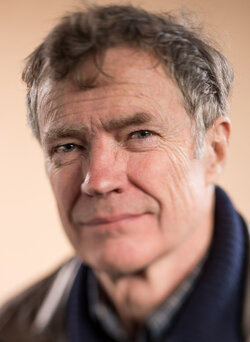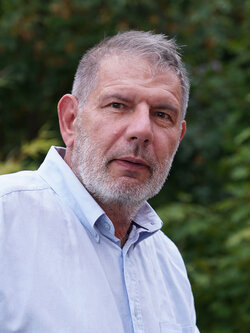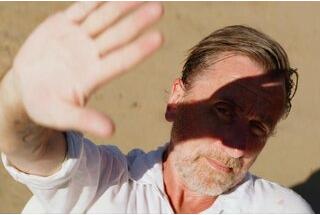Interview with Didier Diaz, President of The Studios de Paris
By Eric Guichard, AFC, Jean-Noël Ferragut, AFC, and Vincent Jeannot, AFCJean-Noël Ferragut : What does it mean to be the Director of the Studios de Paris ?
Didier Diaz : It means a lot of involvement and time !
First, I’d like to tell you about the studios that we have here at The Studios de Paris. There are three investors : Luc Besson, who owns about 50%, Euromedia, which owns about 25%, and Tarak Ben Amar who also has about 25%. They own the buildings and the property. They had the good idea of incorporating an operating company with the same shareholders and the same percentages of ownership. This idea was put into action and I was nominated as the President because I know the three shareholders very well : I know Luc, I am a Euromedia executive, and I have known Tarak since his very beginnings in this industry. Time will tell…
My job is basically to do liaison. There is also the passionate side, the aspect of the job that you know all about. When we took over the Studios d’Arpajon, I became close with Pascal Bécu and Pierre-Luc Forveille in order to find solutions to the problems they were experiencing at the time. Before that, I was close with Julien Derode who had made me manager of the Studios de Boulogne. Studios have always interested me, not from a financial point of view, but rather from the point of view of an industry insider and for the magical side of things.
Eric Guichard : Why were these new studios built ?
DD : We are caught between two contradictions. On one hand, we don’t have the facilities necessary for hosting foreign films. On the other hand, we think that the facilities that we have built are oversized for the needs of the French market. Now that we have built the facility, foreign films will only come if they find a favourable tax situation in France. We really need to be helped out. I hope that our political leaders will understand the French problem with tax credits. I hope that we take the time to meet with the politicians and show them the numbers, and then I really believe that they won’t be able to brush us off, I am really, truly convinced of that.
We all know how much foreign outsourcing costs us ! It’s a huge amount of money and I’m not sure we’re currently capable of evaluating just how great the economic consequences truly are. For example, in order to attract American productions, the Canadians performed full calculations, and took the time to properly analyse things. When they went to see the politicians, they were obviously able to sway them.
That being said, we should go talk to the guy who came up with “tax shelters” in Germany. It was a cinema man with lots of political connections. He want to see the Minister and said “Listen, I need 60 million Euros !”
– “Have you gone mad, man ?”
– “We need 60 million Euros, we’re going to get foreign films to come, and you’ll see…”.
And the Minister was so taken aback that he answered, “Listen, okay, but only for a year.”
So he made the money available to them and one year later it was the Minister who was running after the cinema man to say “Hey ! We’re going to do it again ? Right ?” And that’s how they developed their tax credit ! That means that we really need to re-examine the problem because that’s our only chance to make sure the studios stay alive, and us, too. The way I see it, technicians, workers, and experts are all in these together, whether they like it or not.
JNF : When was the project for the Studios de Paris born ?
DD : The first meeting I had with Luc was in 2002. I always asked him why he had come up with this idea. I sought out what his motivation might be : his motivation comes from the day where it was decided that The Fifth Element would be shot in London. Luc left with his cameraman, his production designer, and that’s all. He spent a lot of time over there and he always regretted not having been able to film that movie in France. Following that, he told us : “One day, there will be studios worthy of the name in France.”
Vincent Jeannot : What about the choice of the location ?
DD : Luc knew the power plant because it was where he shot Le Dernier combat (The Last Battle) in 1982. I had filmed there myself in 1974. The plant was saved from demolition by its owner, the electricity company EDF, because it contained an electrical substation. It had formerly been a working power plant that produced electricity for the northern suburbs of Paris. It was no longer in operation, but was mothballed by EDF and preserved exactly as it had been. When Luc saw it again in its abandoned state, he said : “this is a really interesting place, we must do something with it.”
VJ : How did you decide how big each studio should be ?
DD : This is the result of seven years of careful consideration, ten years if you count construction time. Let me take the example of the 4,000 square meter set at la Ferté. There were a few TV advertisements, there was Astérix, there was a filming of Hossein, but when you do the math, that’s less than 50 days a year. That means that it’s not commercially viable unless you have subsidies or sponsors. We calculated how big the most used studios were, and these are the sizes you find here, except for the one, big 2,000 square metre studio. We are making the same bet as the SFP at Bry, at the time of Jean-Charles Edeline, who was a great visionary.
Since times have changed and there is a return to in-studio filming, we really hope to attract big-budget foreign productions, or maybe even make the French want to make films like that. It’s still the same story, if films are made in the big studio, other people will come up with ways to use it. That’s our wager for the 2,000 square meter studio.
EG : Ideally, how many days a year should the studios be used ?
DD : The profit horizon for the studios involves renting each square meter, not taking into account the technological stuff, but just the cinema space, obviously means that we are looking at a much longer length of time than a traditional real-estate investment, otherwise it is impossible. To take the example of the studios at Bry-sur-Marne, when we began working with Pascal Bécu, the studio were rented 50-55% of the time. Today, the use factor is over 80% because they’ve gotten back into the habit, because people feel welcomed, because they have everything they need on location. Here, we’re obviously aiming initially for a much lower figure, but we hope that we’ll be able to attain the same atmosphere as at Bry.
EG : Well, don’t you think that you’ll end up taking business away from Bry ? Do you think there is a market ?
DD : Luc’s strategy from the very beginning was “No extra studios !” The studios at Arpajon have been closed — there were nine of them — along with the three studios at Saint-Ouen that are going to be expropriated — that makes twelve in total. So the facilities we are about to inaugurate are a replacement and not over-capacity.
JNF : How will the studios work in terms of services, camera, machinery, and lighting ?
DD : There will be suppliers and service providers that will come and do what they have to do. The studios can’t finance these investments themselves. We’re going to finance the electrical wiring, naturally. But we are renters of studio space, and our job stops there.
VJ : I have personally always wondered about the level of investment required for industrial-sized studios. Is it really so great ?
DD : Take the example of the 800 square meter studio. We choose a contractor to build it. Usually, we’ll tell him “I want 16 meters plus 2 meters ceiling height.”
– “Why ?” Those aren’t normal specifications.
We’ll tell him : “Because we just need it to be that way…and by the way, I forgot to tell you, no supporting columns, ok ?”
– “Ok, we’ll find a way to hide three or four of them !”
– “No, you’re not going to hide anything at all, the structure has to be self-supporting !” So immediately you’re asking for something exceptional, which is of course much more expensive than normal construction. Luc closely supervised construction.
We went to visit studios all over the world, studies were done. And then everything boils down to what you really want. There really has to be a political desire to see things through. I want to say it again because it’s important : the entire profession must rally behind us, and for once, we all need to cooperate over this project so that we can all enjoy the results. A little bit of solidarity won’t kill us !
We’ve got a lot of visitors, especially foreigners, Chinese and Americans who are curious and interested in our studios and who have strongly encouraged us, and they know what they’re talking about. Lately, an American producer said to me, “You have a wonderful facility, close to Paris, and I promise you that if you have attractive tax credits, in a year you’ll be entirely booked up !” So, gentlemen, there you go. I look forward to seeing you at the official opening ceremony, but especially let’s meet again when the studios are running at full capacity. I would like you to give me your point of view.
(Interview conducted on 1 August 2012 by Eric Guichard AFC, Jean-Noël Ferragut AFC, and Vincent Jeannot AFC – Thumbnail of Didier Diaz / Photo Le Parisien)
- Follow our tour of The Cité du Cinéma and The Studios de Paris.
 En
En Fr
Fr







